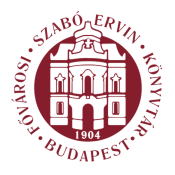Prakfalvi Endre: Roman Catholic Churches in Unified Budapest - Our Budapest (Budapest, 2003)
The Parish Church of the Sacred Heart, 1933
tation marble, and the walls are painted wax-yellow. The neo-Empire furnishings and other appointments were also designed by Lechner. The statue of Patrona Hungáriáé on the main altar is the work of János Pásztor. The busts of the Evangelists on the pendentives of the dome were made by Richárd Füredi. The portal of the entrance is accentuated by a colonnade, with the fronton above its cymatium running around the whole building. Ervin Ybl found it commendable that the designer blended "ancient Hungarian" motifs from the period of the great migrations into antique forms to enrich the effect of the latter (Magyar Építőművészet. Hungarian Architecture, 1931). The Parish Church of the Sacred Heart, 1933 No. 5 Csaba utca, District XII "The Sacred Heart ii the purest heart / The altar oh grace" (Hymn, 1887) The complex standing on the edge of Városmajor comprises three buildings connected by arcades. Designs for the first church were begun after 1919, after the establishment of the parish, in the studio of Aladár Árkay. The church was consecrated in 1925 by Cardinal János Csernoch. This small, three-aisled church, ending in a chancel with a flush closure and featuring two squat, quarry-stone towers on its sides and rick-shaped windows on its triangular gable, displays, with these and other architectural details, influences of Transylvanian folk architecture as well as Finnish national Art Nouveau. It bears a striking resemblance to the Zebegény church (Károly Kós—Béla Jánszky, 1909-10), as a concise monograph of Pál Ritoók observes. Inside the church there is a plaque commemorating the activities in Városliget of Lajos Bárdos, the celebrated composer of church and choral music. In time the building proved to be too small, which is why Budapest’s first church constructed in Modernist style was built next to it (1932-33). Its plans were made by Aladár Árkay and then, joining the project in 1927, his son Bertalan Árkay (1901—71), who had spent some time on a scholarship in Rome as a student at the Hungarian Academy there. With effective help from Emil Kriegs-Au, the parish priest who commissioned the work (himself supported by a decision of Pope Pius XI), the building took shape in successive stages of design and was consecrated by Prince Primate Jusztinján Serédy on 4 June 1933. Supported by a reinforced concrete structure, the flat-roofed hall-church segmented by six
